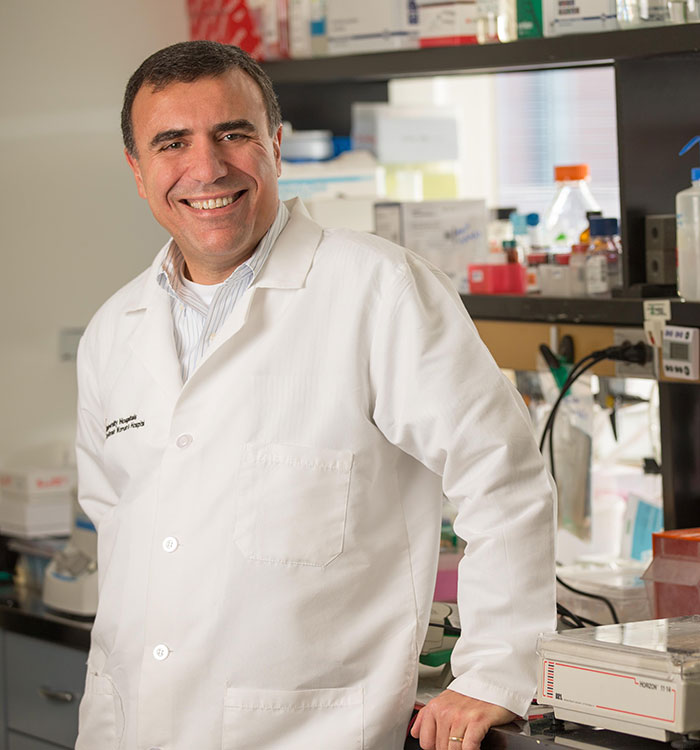Preventing Preterm Birth
February 10, 2019
UH researchers explore new progesterone-based therapies to sustain pregnancy
Innovations in Obstetrics & Gynecology - Winter 2019
Preterm birth, a leading cause of infant mortality and morbidity, occurs in approximately 10 percent of pregnancies worldwide. At University Hospitals, basic research performed by Sam Mesiano, PhD, Vice Chair of Research and Director of the Division of Research in the Department of Obstetrics and Gynecology at UH Cleveland Medical Center, The William H. Weir Professor of Reproductive Biology,
Case Western Reserve University School of Medicine and Program Director of the March of Dimes Prematurity Research Center, Ohio Collaborative, is addressing the causes and exploring potential therapies to prevent preterm birth.
 Sam Mesiano, PhD
Sam Mesiano, PhDDr. Mesiano’s research seeks to understand how the steroid hormone progesterone prepares the uterus to become pregnant and keeps the uterus quiescent to sustain the pregnancy. In all species, this hormone is essential for the maintenance of pregnancy, and labor and delivery occurs when its effects on the gravid uterus are blocked. Dr. Mesiano’s team is hard at work learning more about how progesterone sustains pregnancy, and how its effects are blocked in women to induce labor. Their ultimate goal is to develop progesterone-based therapies to prevent preterm birth.
CURRENT PROGESTERONE-BASED THERAPIES
Currently, progesterone supplementation therapies (P4 therapies) are given to women to decrease the risk for preterm birth. However, P4 therapies are effective only in women who are at high risk of preterm birth. These are women who have had a previous preterm birth or have a small/short cervix detected by ultrasound during the second trimester. Women who have had a previous preterm birth are given a P4 therapy via intramuscular injection, while women with a short cervix are given a P4 therapy via a vaginal suppository.
“Even though it’s clear that progesterone is essential for pregnancy maintenance, it’s still unclear why P4 therapy does not prevent preterm birth in all women,” Dr. Mesiano says.
RESEARCH AT UH
Dr. Mesiano’s team has been studying progesterone to better understand its effects on pregnancy.
“We approach this from the question of ‘how does progesterone work to keep the uterus quiescent, and how its actions are blocked to trigger labor,’” he says. “When we understand that, we can potentially design therapies to boost its pro-pregnancy activity and/or prevent processes that block its activity to induce labor. This rational approach to P4-therapy will likely be effective in preventing preterm birth in the majority of pregnancies.”
In the lab, Dr. Mesiano and his team (including Gregory Tochtrop, PhD, in the Department of Chemistry and Focco van den Akker, PhD, in the Department of Biochemistry at Case Western Reserve University) have developed novel progesterone-like compounds known as selective progesterone modulators, which bind with progesterone receptors in uterine cells to boost the pro-pregnancy actions and prevent the progesterone withdrawal that triggers labor. The team is studying the potential effectiveness of these synthetic compounds in preclinical models of preterm birth.
THE FUTURE OF PROGESTERONE-BASED THERAPIES
Dr. Mesiano’s research was initially backed by the Gates Foundation, which focuses on improving health in low-resource countries, and is currently funded by the National Institutes of Health (NIH). It is hoped that the research will have applications for women without ready access to healthcare during pregnancy.
With that in mind, Dr. Mesiano and his team are exploring orally active compounds, which could eventually translate into a cost-effective and easily administered therapy. They are excited to see that some compounds are achieving what they had predicted in mouse models. While this is promising, Dr. Mesiano knows it will take years to create a therapy that is effective and safe to give to pregnant women.
“We are excited to take our selective progesterone modulator work to the next level and do in-depth experiments with the compounds to see if they are truly effective in preventing preterm birth,” he says.
Dr. Mesiano is confident he is in the right place to support that work, as he can collaborate with the physicians in the Department of Obstetrics and Gynecology at UH Cleveland Medical Center while he conducts his research.
“The value of being at UH,” he says, “is working with world class physician-scientists in an outstanding collegiate and academic environment that facilitates the translation of discoveries at the laboratory bench to better health for mothers and babies.”
Contact Dr. Mesiano at OBGYNInnovations@UHhospitals.org.


